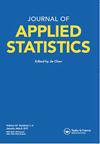两阶段抽样下有限总体的gwr辅助综合估计:一种模型辅助方法
IF 1.2
4区 数学
Q2 STATISTICS & PROBABILITY
引用次数: 0
摘要
摘要在调查抽样中,利用辅助信息对有限的总体参数进行精确估计。在文献中有几种可用的方法,提供了在估计阶段合并辅助信息的实用方法。为了有效地利用辅助信息,本文提出了一种地理加权回归(GWR)模型辅助的两阶段抽样设计下有限总体总数的综合估计方法。空间模拟研究已经进行,以经验评估所提出的估计器的统计特性。在存在空间非平稳性的情况下,实证结果表明,所提出的估计量优于所有现有的估计量,如两相HT估计量、比率估计量和回归估计量,证明了空间信息在调查抽样中的重要性。关键词:数据整合地理加权回归模型辅助方法空间非平稳性两阶段回归感谢盲审稿人提供的宝贵意见,极大地提高了文章的质量。第一作者衷心感谢印度新德里icar -印度农业统计研究所(ICAR-Indian Agricultural Statistics Research Institute, New Delhi, India)为博士期间的研究工作提供了真实的CCE调查数据、实验室设施和全面的支持。披露声明作者未报告潜在的利益冲突。数据可用性声明数据共享不适用。本文章由计算机程序翻译,如有差异,请以英文原文为准。
GWR-assisted integrated estimator of finite population total under two-phase sampling: a model-assisted approach
AbstractIn survey sampling, auxiliary information is used to precisely estimate the finite population parameters. There are several approaches available in the literature that provide a practical method for incorporating auxiliary information during the estimation stage. In order to effectively utilize the auxiliary information, a geographically weighted regression (GWR) model-assisted integrated estimator of finite population total under a two-phase sampling design has been proposed in this article. Spatial simulation studies have been conducted to empirically assess the statistical properties of the proposed estimator. In the presence of spatial non-stationarity, empirical findings reveal that the proposed estimator outperforms all existing estimators such as two-phase HT, ratio, and regression estimators, demonstrating the importance of spatial information in survey sampling.KEYWORDS: Data integrationgeographically weighted regressionmodel-assisted approachspatial non-stationaritytwo-phase regression AcknowledgementThe authors are thankful to the blind reviewers for providing valuable suggestions that have greatly enhanced the quality of the article. The first author would like to express his heartfelt gratitude to the ICAR-Indian Agricultural Statistics Research Institute, New Delhi, India, for providing the real CCE survey data, lab facilities, and overall support to conduct the research work during Ph.D. programme.Disclosure statementNo potential conflict of interest was reported by the authors.Data availability statementData sharing is not applicable.
求助全文
通过发布文献求助,成功后即可免费获取论文全文。
去求助
来源期刊

Journal of Applied Statistics
数学-统计学与概率论
CiteScore
3.40
自引率
0.00%
发文量
126
审稿时长
6 months
期刊介绍:
Journal of Applied Statistics provides a forum for communication between both applied statisticians and users of applied statistical techniques across a wide range of disciplines. These areas include business, computing, economics, ecology, education, management, medicine, operational research and sociology, but papers from other areas are also considered. The editorial policy is to publish rigorous but clear and accessible papers on applied techniques. Purely theoretical papers are avoided but those on theoretical developments which clearly demonstrate significant applied potential are welcomed. Each paper is submitted to at least two independent referees.
 求助内容:
求助内容: 应助结果提醒方式:
应助结果提醒方式:


